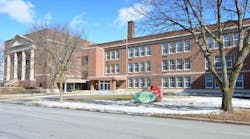Middle school transformed into affordable housing for seniors
Constructed in 1930, the Watkins Glen Middle School building features a brick façade and historic details such as its large hallways, solid wood doors, and the craftsmanship of its masonry. But as the town began to consolidate its school buildings, the structure was no longer needed as a school.
In an effort to repurpose the architecturally pleasing building while also tackling the problem of affordable housing, it was suggested to use the retired school building as a reinvestment and repurpose it as 51 affordable housing units for seniors.
One of the main challenges of the project was to maintain the existing character of the building while assuring that upgrades met energy efficiency standards and the U.S. Green Building Council’s LEED for Homes program conditions.
For example, compromises needed to be made with green building or energy efficiency standards when it came to preserving historic walls and window details. The finished project achieved LEED for Homes Silver certification by maximizing material reuse points; implementing air sealing measures; selecting new windows, a high efficiency boiler for heating and hot water, and Energy Star appliances; and for its great location, close to many amenities.
The auditorium was preserved as a civic space and represents the area’s largest gathering space and each converted unit has a unique layout, setup, and details.
Repurposing the building required $14.2 million in funding, which it achieved via a combination of NYSHCR financing, Historic Tax Credits from the State Historic Preservation Office (SHPO) and National Park Service, and incentives from New York State Energy Research & Development (NYSERDA).
